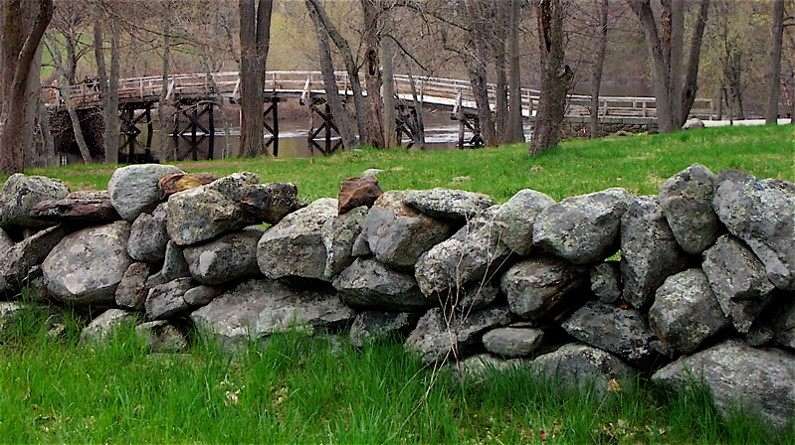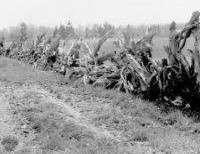Up and down the Kennebec Valley: Agriculture – Part 1
by Mary Grow
Early days
Families who settled the central Kennebec Valley in the 1700s were, of necessity, farmers: one of the first actions was to clear enough land to raise food crops, for both people and livestock.
Alice Hammond wrote in her history of Sidney, “In the late 18th century, almost every Sidney home would have been a self-sufficient farm, with oxen, dairy cows, sheep, chickens, and steadily expanding fields that provided food for people and livestock.”
The Fairfield bicentennial history quoted from an 1848 letter in which Elihu Bowerman recollected his first years in North Fairfield, in 1783 and 1784. As he remembered, the log cabin came first. He raised potatoes on the farm of a fellow Quaker, in Vassalboro, Remington Hobby (or Hobbie; Hobbes in Bowerman’s account), but they froze early in the fall; his winter diet was corn (bought on credit), frozen potatoes and “pork and smoked herring.”
The next spring, Bowerman wrote, he and his brother cleared enough more land to plant “corn, potatoes, beans and some other things, but no wheat.”
Clearing land was no simple job; several historians talk about the immense trees the first settlers found. In what became the Town of Palermo, Milton Dowe wrote, trees were up to 250 feet tall, “and some of the stumps, when cut, were large enough for a team of oxen to turn on.”
And, Windsor historian Linwood Lowden reminded his 20th-century readers, those stumps “must be pried, pulled, dug and/or burned out, and the war against recurring saplings must be joined.”
Ruby Crosby Wiggin, in her Albion history, mentioned using “oxen-power” in later years to pull gigantic pine stumps and use them for fences – very effective fences, she assured her readers.
Lowden added large rocks to the farmers’ problems. Really big ones, he wrote, might be drilled, split and used for building foundations or lining wells; others could become stone fences.
As the cleared land was cultivated, smaller stones kept surfacing. These, Lowden said, were loaded onto a stone drag pulled by oxen and taken to the stone dump that every farm had, “either at a place where the woodlot met an open field, or in a corner of two stone fences, or perhaps atop an outcrop of ledge.”
Lowden wrote that at least one Windsor farmer was growing rye by the summer of 1783. He cited an 1807 letter from a farmer named John Linn, who was raising “corn, wheat, rye, and hay,” and quoted Linn’s praise of the potato as “the pioneer’s main stay.”
Wiggin wrote that by 1809, people in the future Town of Albion were raising wheat, rye, corn, oats and peas, among other crops. She listed them because that year, voters agreed to accept those produce items in payment of taxes, provided they were less than a year old.
Dowe generalized that early settlers’ gardens produced “corn, wheat, potatoes, onions and beets.” His fellow Palermo historian, Millard Howard, added by 1820 oats, barley, peas and beans.
Quoting a South Freedom farmer’s report at the end of 1851, Howard said potatoes were raised for animal feed until an 1845 crop failure. The farmer wrote that in 1851 the potatoes rotted less than in any of the preceding five years.
A typical late-1700s or early-1800s farm would have livestock: horses, cows, oxen, swine, sheep. Some agricultural statistics broke down the “cow” category, for example listing separately steers (neutered males).
Vassalboro historian Alma Pierce Robbins quoted a 1792 census report: within the town, there were “96 cows, 114 oxen, 37 horses, 104 steers, and 124 swine.” The town had a tannery and a slaughterhouse by then. Robbins did not mention the human population that year; an on-line source says 1,253 as of the 1790 census.
(The 1790 number would have counted residents of what is now Sidney, on the west side of the Kennebec. Sidney became a separate town from Vassalboro on Jan. 30, 1792, so the 1792 report probably covered only the east side of the river. The 1800 census recorded 1,188 inhabitants in Vassalboro and 1,011 in Sidney.)
Cows and steers provided milk, cream, butter and meat. Horses and oxen were main means of transportation for goods and people. Dowe, again generalizing, described a couple on their way to church: “The man rode in the saddle with his wife behind him.”
Though farming families were self-sufficient, Lowden wrote that self-sufficiency did not exclude cooperation. He gave examples from an “account book” Gideon Barton kept beginning in 1808, recording “debits of work and the loan of animals and farm equipment against similar credits among his neighbors.”
Some Windsor residents could and did pay in cash, but, Lowden wrote, “At a time when currency was scarce, the bartering of work was a convenient and necessary way of life.”
Thus, in the fall of 1811, Elisha Pike “helped Barton butcher a hog and a cow. Another time Barton helped Pike butcher an ox, and the next year they butchered a cow together.”
Records showed Barton hauling rocks and pasturing cows and horses for one neighbor and helping another build a new barn.
Town government in the Kennebec Valley in the early days of European settlement was tailored to an agricultural economy. Town officials included some elected specifically to deal with livestock; early records list appointments of hog-reeves, field-drivers and pound-keepers.
In 1805, Ephraim Clark was elected pound-keeper in China (then Jones Plantation), Henry Kingsbury said in his Kennebec County history, “and he is reported as holding the office for life.” Clark, born July 15, 1751, and one of China’s first settlers in the summer of 1774, died Oct. 20, 1829, at the age of 78.
Farm animals were not infrequently a topic on a town meeting agenda.
In August 1771, according to Kingsbury, Vassalboro voters authorized two town pounds to contain stray animals. They directed male residents to build them that December; any man who did not come to help was to be fined.
While Palermo was the plantation named Great Settlement, from 1801 through 1804, Dowe wrote that plantation voters decided that “Hogs should run at large, provided they be yoked and ringed.”
A yoke was a wooden neck-collar, similar to yokes used to hitch a pair of oxen or occasionally put on one ox. A ring was a nose-ring; its purpose was to keep a wandering hog from rooting and digging on other people’s and the public’s land. A hog-reeve’s responsibility was to catch and impound any stray hog not properly accountered.
That same year, 1804, according to Wiggin’s Albion history, voters at an April 16 town meeting decreed that “swine shall not go ‘at large.'” They also banned horses on “the common” and elected a pound-keeper, apparently the town’s first.
(By then, what is now Albion had changed from Freetown Plantation, incorporated in 1802, to Fairfax, as of March 9, 1804. The reference to “the common” is a puzzlement, because Wiggin wrote that in July 1806 voters chose a committee to buy land for a central town common, but she could find no record of such a purchase.)
China must have had a common by 1803, because Kingsbury recorded a town meeting vote that year prohibiting geese from running on it.
Wiggin recorded another interesting vote in April 1805: voters decided that “hogs and sheep ‘shall not run at large, but that Phineas Farnham’s sheep shall have the privilege of the road the width of his lot.'”
(Phineas Farnham was born April 1, 1767, in Woolwich, and died Dec. 14, 1837, in Albion. Early in 1791 he married Elizabeth “Betsey” Stinson, of Woolwich; she died there in May 1824. Their daughter Joanna, born in 1790, married James Chalmers, of Albion, in 1811; they had eight children.
(Wiggin had mentioned Farnham once before in her history, as one of two bondsmen for the tax collector elected at the first Freetown Plantation meeting on Oct. 30, 1802. She did not say what road he lived on.)
Farms produced not only food, but household items. Dowe mentioned mattresses filled with corn husks, hay or feathers.
Wool from a farm’s sheep could be taken to a fulling mill to be made into cloth. Samuel Boardman, in the chapter on agriculture in Kingsbury’s history, added cultivation of flax to provide rough tow cloth (for sacks, for example) and smoother linen.
Boardman was enthusiastic about the suitability of the central Kennebec Valley for farming. The whole county, he wrote, is far enough inland to escape salt air and coastal fog, far enough from mountains to stay warmer and “one of the best watered sections of Maine.”
Although Kennebec County soils vary from place to place, Boardman wrote that overall, the county “is a rich grazing section, excellent for the production of grass, the hill farms among the best orchard lands in the state, the lands in the river valleys and in the lower portions between the hills and ridges, splendid for cultivation.”
Boardman named Albion, Benton, Clinton and Windsor “excellent grazing towns.” China, Sidney and Vassalboro he listed (with Manchester, Monmouth, Readfield and Winthrop) as “without question the garden towns of the county.” He mentioned the “fine, deep, rich, productive loam” in the parts of Winslow along the Kennebec and Sebasticook rivers.
He credited Kennebec County’s early farmers with initiating agricultural development for the whole state. He described these farmers as “men of intelligence, anxious for improvement,” eager to promote new types of plants and animals and new tools and machinery and to share knowledge through organizations, “books and journals” and popular education.
A story about a New England stump fence
Ruby Crosby Wiggin told a pleasant story about a stump fence that ran along George Hanscom’s line to the shore of Albion’s Lovejoy Pond, where, in the early 1900s, her father and other boys often skated late into the evening. For several nights in a row, she said, the boys took a stump from the fence, dragged it onto the ice and built a bonfire to warm themselves.
When Hanscom checked his fence the next spring, he was so angry he asked a town official named Charles Abbott if he could have the vandals prosecuted.
Abbott had a good idea who was to blame, and he knew the families involved were his and Hanscom’s friends. So he proposed to Hanscom that the culprits buy and install enough wire fencing to replace the missing stumps.
Hanscom calmed down and consented; the boys bought enough wire to fill the gap they’d made and continue beyond it; and Hanscom, satisfied, offered them the stumps they’d supplemented with wire for the next winter’s bonfires.
Main sources
Dowe, Milton E., History Town of Palermo Incorporated 1884 (1954).
Fairfield Historical Society Fairfield, Maine 1788-1988 (1988).
Hammond, Alice, History of Sidney Maine 1792-1992 (1992).
Howard, Millard, An Introduction to the Early History of Palermo, Maine (second edition, December 2015).
Kingsbury, Henry D., ed., Illustrated History of Kennebec County Maine 1625-1892 (1892).
Lowden, Linwood H., good Land & fine Contrey but Poor roads a history of Windsor, Maine (1993).
Robbins, Alma Pierce, History of Vassalborough Maine 1771 1971 n.d. (1971).
Wiggin, Ruby Crosby, Albion on the Narrow Gauge (1964).
Websites, miscellaneous.
Responsible journalism is hard work!
It is also expensive!
If you enjoy reading The Town Line and the good news we bring you each week, would you consider a donation to help us continue the work we’re doing?
The Town Line is a 501(c)(3) nonprofit private foundation, and all donations are tax deductible under the Internal Revenue Service code.
To help, please visit our online donation page or mail a check payable to The Town Line, PO Box 89, South China, ME 04358. Your contribution is appreciated!








Leave a Reply
Want to join the discussion?Feel free to contribute!